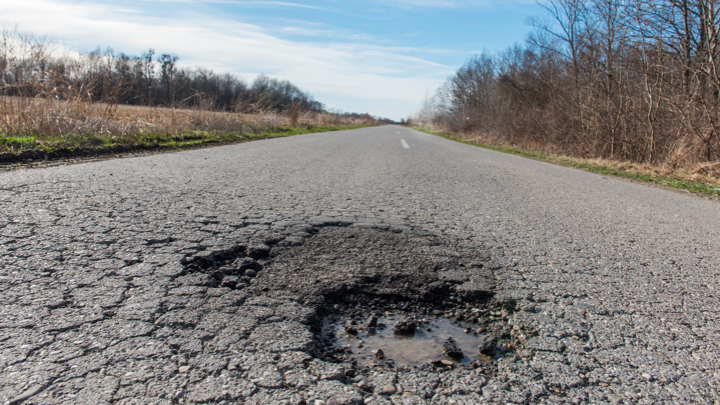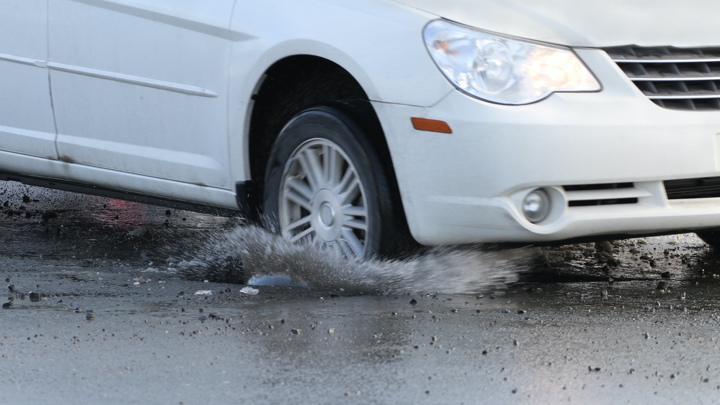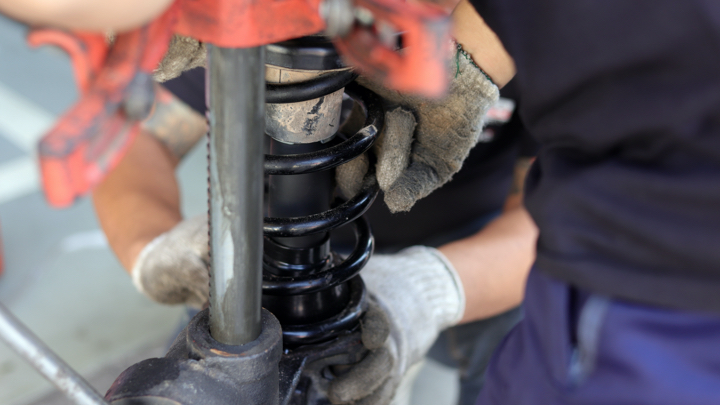Shocks 101
Pothole Damage & Your Suspension System
Road Hazards

Whether you drive in the snow and cold of the north or in the sun and heat of the south, potholes are an unfortunate fact of life. Potholes aren’t just a roadway nuisance; they can do real damage to your vehicle and to your wallet.
US drivers pay approximately $3 billion a year for vehicle damage due to potholes. In a 2016 study by AAA, it found that $15 billion was spent by US drivers on car repairs to fix pothole damage over the previous five years.
How Potholes Form

Potholes develop when water on the road seeps under the pavement through cracks in the road. When the temperature drops below 32°, the water freezes and expands, forcing the pavement to rise. As the day heats up and the temperature rises, the compromised section of the road contracts and breaks as vehicles drive over the pavement. The result is a pothole in the road.
In cold climates, the freeze-thaw cycles during winter and spring are a key contributing factor to the formation of potholes. The more freeze-thaw cycles a pothole goes through, the larger the pothole can become.
In warm climates, heat is the culprit. Heat causes splits in the road that serve as an entry point for water. The pothole forms as traffic goes over the gap in the pavement causing the top layer of the road to crumble.
Damage to Shocks and Struts

Hitting a pothole is a helpless feeling; you immediately worry about the damage that might be happening to your vehicle as your car hits the large hole in the pavement. In addition to obvious tire damage like a blowout, repeatedly running over potholes can cause damage to many other parts of your vehicle as well, including suspension system components like shocks and struts. When you hit a pothole, it rocks the entire suspension system and can cause premature wear and tear on shocks and struts.
Spotting damage to shocks and struts can be tricky. A flat tire or bent rim is obvious after slamming into a pothole; you’ll have a hard time driving with either of these problems. Damage to your shocks and struts can be difficult to spot, so you need to be on the lookout for the signs.
Your vehicle may not ride as well as it used to. You may notice:
- Excessive bouncing
- Bottoming out
- Loss of control
- Swaying and rolling when turning from worn shocks losing the ability to control the rate of weight transfer
- Excessive vibration
- Front end diving when braking
- Squatting when accelerating
- Sitting lower in front or rear
- Uneven tire wear
Fixing Pothole Damage
If you suspect that your vehicle has sustained suspension damage after hitting a pothole, take it to your service provider for a thorough inspection. You will want to consider getting an alignment check and having a service provider complete a ride test and physical inspection for damaged or worn shocks and struts that may need to be replaced. The longer you put it off, you run the risk for additional damage the next time you hit a pothole.
Avoiding Potholes
While it can seem like potholes come out of nowhere, there are some things you can do to avoid potholes and the damage they inflict. As you drive, look ahead in the road to scout out these annoying hazards. When you spot a pothole, try to safely steer around the obstruction. If there is no way to safely avoid a large road impact, reduce your speed as you approach the pothole and hit it straight on. Striking a pothole at a slower speed may help you avoid damage to your vehicle.
Keeping your tires properly inflated may help you avoid costly pothole repairs. Your tires are the first to absorb the impact of a pothole, so keeping them inflated at the manufacturer’s recommended PSI and making sure they have sufficient tread can help you in the battle against potholes.
Finally, avoid driving through puddles and standing water. Potholes can lurk beneath the water, just waiting for the next unsuspecting motorist to hit it. You can’t avoid obstructions that you can’t see.
Learn more about quality shocks, struts, and strut assemblies, find the right car part, or find a local repair shop today.
The content in this article is for informational purposes only. You should consult with a certified technician or mechanic if you have questions relating to any of the topics covered herein. Tenneco will not be liable for any loss or damage caused by your reliance on any content.